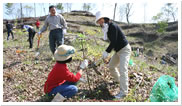 |
|
 |

 |
 |
The number of nectar tree forests and wooded areas is decreasing throughout the country. As part of our job in beekeeping, we are learning how to contribute by taking care of nature and how to restore nature to its native and precious state.
One of our contributions is the restoration of a 10 hectare area in the center of the mountain village located in Kagaminocho. Yamada Bee Farm for the past six years has invited children out to this mountainous area every year to let them experience geco-school,h our program designed to let children take part in beekeeping.
Historically, this area had a charcoal and fuel industry (from trees) as well as grew vegetables and kinoko, a type of mushroom, though this activity has ceased. We are advising the area on how to breathe new life into the mountainous region by planting various species of nectar trees.
 On April 29, the Japanese gGreen Dayh holiday, members from Yamada Bee Farm planted clementine, loquat, and other types of citrus trees. In total, with all types of trees accounted for, we planted approximately 30,000 trees. In a few more years, we eagerly await the interaction the bees will have with the forest. On April 29, the Japanese gGreen Dayh holiday, members from Yamada Bee Farm planted clementine, loquat, and other types of citrus trees. In total, with all types of trees accounted for, we planted approximately 30,000 trees. In a few more years, we eagerly await the interaction the bees will have with the forest.
In addition, in order to increase the number of nectar-producing trees, we have planted acacia and other types of trees in various regions in the north of Okayama prefecture. We call the location a gBee Pastureh where people, nature, and bees can be together as one, and we hope that you will come to visit our bee pasture and enjoy a first-hand experience with nature. |


|
 |



